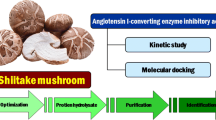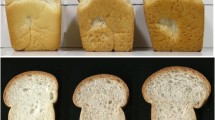Abstract
The degree of hydrolysis (DH) and angiotensin I-converting enzyme (ACE)-inhibitory activity of vital wheat gluten (VWG) hydrolyzed using Alcalase were investigated using Box-Behnken response surface methodology (RSM). The mean responses were fitted to a second order polynomial to obtain regression equations. The enzyme-substrate ratio and the hydrolysis time increased the DH significantly (p<0.05). The substrate concentration was the only significant linear term leading to an increase in ACE-inhibitory activity. The optimized conditions of a substrate concentration of 5.04%, an enzyme-substrate ratio 5.94%, and a hydrolysis time 30.79 min gave a point prediction of a 12.74% DH and 82.28% ACE-inhibitory activity. Analytical results from confirmatory experiment were a 12.22%±0.5 DH and a 78.93%±1.07 ACE-inhibitory activity. The optimized conditions of the study provide useful information to the functional food and beverage industries to enhance the anti-hypertensive activities of peptides from VWG.
Similar content being viewed by others
References
Kong X, Zhou H, Qian H. Enzymatic hydrolysis of wheat gluten by proteases and properties of the resulting hydrolysates. Food Chem. 102: 759–763 (2007)
Saiga A, Kanda K, Wei Z, Okumura T, Kaneko T, Nishimura T. Hypotensive activity of muscle protein and gluten hydrolysates obtained by protease treatment. J. Food Biochem. 26: 391–401 (2007)
Motoi H, Kodama T. Isolation and characterization of angiotensin Iconverting enzyme inhibitory peptides from wheat gliadin hydrolysate. Nahrung. 47: 354–358 (2003)
Hernández-Ledesma B, Del Mar Contreras M, Recio I. Antihypertensive peptides: Production, bioavailability and incorporation into foods. Adv. Colloid. Interfac. 165: 23–35 (2011)
Cuie G, Phillips R. Microplate kinetic assay of ACE activity and response surface methodology of hydrolysis factors of peanut and cowpea flours by alcalase. J. Food Agr. Environ. 10: 58–63 (2012)
Chen ZY, Peng C, Jiao R, Wong YM, Yang N, Huang Y. Antihypertensive nutraceuticals and functional foods. J Agr. Food Chem. 57: 4485–4499 (2009)
Barbana C, Boye JI. Angiotensin I-converting enzyme inhibitory properties of lentil protein hydrolysates: Determination of the kinetics of inhibition. Food Chem. 127: 94–101 (2011)
Kuster DJ, Marshall GR. Validated ligand mapping of ACE active site. J. Comput Aid Mol. Des. 19: 609–615 (2005)
Erdmann K, Cheung BW, Schröder H. The possible roles of foodderived bioactive peptides in reducing the risk of cardiovascular disease. J. Nutr. Biochem. 19: 643–654 (2008)
Balasuriya BN, Rupasinghe HV. Plant flavonoids as angiotensin converting enzyme inhibitors in regulation of hypertension. Funct. Food. Health Dis. 5: 172–188 (2011)
Lopez-Fandino R, Otte J, Van Camp J. Physiological, chemical and technological aspects of milk-protein-derived peptides with antihypertensive and ACE-inhibitory activity. Int. Dairy J. 16: 1277–1293 (2006)
FitzGerald RJ, Murray BA, Walsh DJ. Hypotensive peptides from milk proteins. J. Nutr. 134: 980S–988S (2004)
Saito T. Antihypertensive peptides derived from bovine casein and whey proteins. Bio. Comp. Milk 295–317 (2008)
Suh H, Whang J, Kim Y, Bae S, Noh D. Preparation of angiotensin I converting enzyme inhibitor from corn gluten. Process Biochem. 38: 1239–1244 (2003)
Li GH, Qu MR, Wan JZ, You JM. Antihypertensive effect of rice protein hydrolysate with in vitro angiotensin I-converting enzyme inhibitory activity in spontaneously hypertensive rats. Asia Pac. J. Clin. Nutr. 16: 275–280 (2007)
Del Castillo MD, Ferrigno A, Acampa I, Borrelli RC, Olano A, Martínez-Rodríguez A, Fogliano V.I In vitro release of angiotensinconverting enzyme inhibitors, peroxyl-radical scavengers and antibacterial compounds by enzymatic hydrolysis of glycated gluten. J. Cereal Sci. 45: 327–334 (2007
He GQ, Xuan GD, Ruan H, Chen QH, Xu Y. Optimization of angiotensin I-converting enzyme (ACE) inhibition by rice dregs hydrolysates using response surface methodology. J. Zhejiang Univ. Sci. 6: 508 (2005)
Ren J, Zhao M, Shi J, Wang J, Jiang Y, Cui C, Kakuda Y, Xue SJ. Optimization of antioxidant peptide production from grass carp sarcoplasmic protein using response surface methodology. LWTFood Sci. Technol. 41: 1624–1632 (2008)
Tavares T, Contreras M, Amorim M, Martín-Álvarez P, Pintado M, Recio I, Malcata F. Optimisation by response surface methodology, of degree of hydrolysis and antioxidant and ACE-inhibitory activities of whey protein hydrolysates obtained with cardoon extract. Int. Dairy J. 21: 926–933 (2011)
Van der Ven C, Gruppen H, de Bont D, Voragen AG. Optimisation of the angiotensin converting enzyme inhibition by whey protein hydrolysates using response surface methodology. Int. Dairy J. 12: 813–820 (2002)
Guo Y, Pan D, Tanokura M. Optimisation of hydrolysis conditions for the production of the angiotensin I-converting enzyme (ACE) inhibitory peptides from whey protein using response surface methodology. Food Chem. 114: 328–333 (2009)
Adler-Nissen J. Enzymic Hydrolysis of Food Proteins. Elsevier Applied Science Publishers (1986)
Shalaby SM, Zakora M, Otte J. Performance of two commonly used angiotensin-converting enzyme inhibition assays using FA-PGG and HHL as substrates. J. Dairy Res. 73: 178 (2006)
Adler-Nissen J. Determination of the degree of hydrolysis of food protein hydrolysates by trinitrobenzenesulfonic acid. J. Agr. Food Chem. 27: 1256–1262 (1979)
Kamau SM, Lu RR. The effect of enzymes and hydrolysis conditions on degree of hydrolysis and DPPH radical scavenging activity of whey protein hydrolysates. Curr. Res. Dairy Sci. 3: 25–35 (2011)
Chiang WD, Tsou MJ, Tsai ZY, Tsai TC. Angiotensin I-converting enzyme inhibitor derived from soy protein hydrolysate and produced by using membrane reactor. Food Chem. 98: 725–732 (2006)
Matsui T, Matsufuji H, Seki E, Osajima K, Nakashima M, Osajima Y. Inhibition of angiotensin I-converting enzyme by Bacillus licheniformis alkaline protease hydrolyzates derived from sardine muscle. Biosci. Biotech. Bioch. 57: 922 (1993)
Diniz FM, Martin AM. Use of response surface methodology to describe the combined effects of pH, temperature and E/S ratio on the hydrolysis of dogfish (Squalus acanthias) muscle. Int. J. Food Sci. Tech. 31: 419–426 (2003)
Wani AA, Kaur D, Ahmed I, Sogi DS. Extraction optimization of watermelon seed protein using response surface methodology. LWTFood Sci. Technol. 41: 1514–1520 (2008)
Abas Wani A, Sogi D, Grover L, Saxena D. Effect of temperature, alkali concentration, mixing time and meal/solvent ratio on the extraction of watermelon seed proteins-a response surface approach. Biosyst. Eng. 94: 67–73 (2006)
Author information
Authors and Affiliations
Corresponding author
Rights and permissions
About this article
Cite this article
Dadzie, R.G., Ma, H., Abano, E.E. et al. Optimization of process conditions for production of angiotensin I-converting enzyme (ACE) inhibitory peptides from vital wheat gluten using response surface methodology. Food Sci Biotechnol 22, 1531–1537 (2013). https://doi.org/10.1007/s10068-013-0248-9
Received:
Revised:
Accepted:
Published:
Issue Date:
DOI: https://doi.org/10.1007/s10068-013-0248-9




